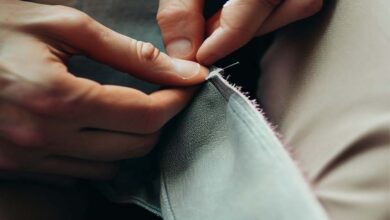Should I Use Landscape Fabric under Gravel?

When it comes to creating a beautiful and low-maintenance landscape, gravel is a popular choice. Its versatility and durability make it an excellent option for pathways, driveways, or even as ground cover in gardens. However, one question often arises, Should I Use Landscape Fabric under Gravel?
Yes, using landscape fabric under gravel can help control weeds and maintain a stable base for the gravel. Proper installation and maintenance are crucial for its effectiveness.
However, Proponents argue that it helps prevent weeds from growing through the gravel, while others believe it may hinder drainage and cause more harm than good. In this article, we will explore the pros and cons of using landscape fabric under gravel to help you decide whether or not it’s right for your landscaping project.
What Is Landscape Fabric?
Landscape fabric, also known as weed barrier fabric or geotextile fabric, is a material used in gardening and landscaping projects. It is typically made from woven or non-woven synthetic fibers and is designed to suppress the growth of weeds and provide a barrier between the soil and the gravel layer.
This fabric serves as a foundation for installing gravel pathways, driveways, or decorative gravel areas.
Should I Use Landscape Fabric under Gravel?
Whether or not to use landscape fabric under gravel depends on your specific situation and landscaping goals. Here are some factors to consider when deciding whether landscape fabric is appropriate for your gravel installation:
Weed Control:
One of the main reasons people use landscape fabric is to prevent weed growth. Suppose weed control is a significant concern in your outdoor space. In that case, landscape fabric can effectively suppress weed growth, creating a barrier that inhibits weed seeds from germinating.
However, remember that some determined weeds may still find a way to grow on top of the gravel, mainly if organic matter accumulates on the surface.
Drainage:
Landscape fabric can affect the drainage of water through the gravel. While it allows water to pass through, it also creates a barrier that could impede the natural movement of water.
In areas with heavy rainfall, this might lead to water pooling on the surface, reducing the effectiveness of the gravel as a drainage solution. If proper drainage is essential for your landscaping project, you might consider alternatives, such as using a gravel base with no landscape fabric.
Longevity:
Landscape fabric can break down over time due to exposure to sunlight and environmental factors. As it degrades, it can become less effective in preventing weed growth and might need replacement eventually. If you choose landscape fabric, opt for high-quality, UV-resistant fabric to extend its lifespan.
Maintenance:
While landscape fabric can reduce the weeding frequency, it doesn’t eliminate maintenance. Debris, dirt, and organic matter can accumulate on the gravel over time, allowing weeds to grow in the accumulated material. Regular cleaning and maintenance are still necessary to keep the area weed-free.
Cost:
Landscape fabric adds cost to your landscaping project. If weed control is your primary concern, you might consider other methods, such as herbicides or mulching, which could be more cost-effective.
Aesthetics:
Some people prefer the natural look of gravel without landscape fabric, while others prioritize a more polished and clean appearance. Consider the overall aesthetic you want to achieve in your outdoor space.
Ultimately, landscape fabric can be a valuable tool for weed control, but weighing its pros and cons against your specific needs and goals is essential. If you decide to use landscape fabric, make sure to install it properly and choose a high-quality product. Additionally, regular maintenance is crucial to keeping your gravel area looking its best.
Benefits Of Using Landscape Fabric Under Gravel

Using landscape fabric under gravel can provide various benefits for your outdoor spaces. Here are some key advantages:
- Weed control: Landscape fabric acts as a barrier, preventing weeds from growing through the gravel. This helps in reducing maintenance and the need for herbicides.
- Moisture retention: The fabric allows water to pass through to the soil while retaining moisture, which can benefit plant roots during dry periods.
- Erosion prevention: By creating a stable base, landscape fabric helps to minimize erosion and soil movement, especially on slopes.
- Improved drainage: The fabric can help to improve drainage by preventing the gravel from becoming compacted and allowing water to flow freely.
- Reducing shifting: Landscape fabric can help to stabilize the gravel, reducing shifting and the need for frequent re-leveling.
- Enhance aesthetics: By providing a clean and tidy appearance, landscape fabric can enhance the overall aesthetics of your gravel areas.
- Pest control: Using landscape fabric can act as a barrier to certain pests, helping to protect your plants and garden from damage.
- Longevity: Landscape fabric can help prolong your gravel areas’ lifespan by preventing weed growth and reducing shifting.
These benefits make landscape fabric a valuable addition when using gravel in outdoor spaces, offering weed control, moisture retention, erosion prevention, improved drainage, stability, aesthetics, pest control, and increased longevity.
Pros Of Using Landscape Fabric Under Gravel:
- Landscape fabric is a barrier, preventing weeds from penetrating through the gravel.
- Landscape fabric can help maintain proper drainage by preventing the gravel from compacting.
- Landscape fabric can protect the underlying soil from erosion, ensuring the stability of your landscape.
- Placing landscape fabric under the gravel reduces the likelihood of rocks moving and migrating over time.
- Landscape fabric can create a clean and professional look, keeping the gravel separate from the soil and other elements.
Cons Of Using Landscape Fabric Under Gravel:
- Once the landscape fabric is installed, removing it can be challenging if you decide to make changes in the future.
- Landscape fabric can deteriorate over time, especially if exposed to sunlight and harsh weather conditions.
- Landscape fabric may hinder the transfer of nutrients from the soil to the plants, impacting their growth.
- Some plants may struggle to establish roots or may be restricted by the landscape fabric, leading to stunted growth.
While landscape fabric can offer advantages such as weed control and improved drainage, it’s essential to consider the long-term implications and potential drawbacks. By weighing the pros and cons, you can determine whether landscape fabric under gravel is the right choice for your project.
Ultimately, you should evaluate your project’s specific needs and goals and the maintenance and future plans you have in mind.
Factors To Consider Before Installing Landscape Fabric
Installing landscape fabric under gravel can be a great way to help prevent weed growth and maintain a tidy appearance in your outdoor space. However, a few factors must be considered before diving into this project. By considering these factors, you can ensure that landscape fabric is the right choice for your specific needs and conditions.
Soil Type And Composition
When deciding whether to use landscape fabric under gravel, it is vital to consider the type and composition of your soil. Here are some key points to keep in mind:
- Clay soil: If you have clay soil, landscape fabric can be beneficial as it helps to improve drainage by preventing the soil from becoming compacted under the weight of the gravel.
- Sandy soil: Sandy soil is naturally well-draining, so using landscape fabric may not be necessary unless you specifically want to prevent weed growth.
- Loam soil: Loam soil is a balanced combination of clay, sand, and silt. Landscape fabric can help prevent soil erosion and maintain a stable base for your gravel.
Climate And Weather Conditions
Your area’s climate and weather conditions significantly determine whether landscape fabric should be used under gravel. Consider the following points:
- Rainfall: If you live in an area with heavy rainfall, landscape fabric can help prevent the soil from becoming muddy and unstable under the gravel.
- Freezing temperatures: In regions with freezing temperatures, landscape fabric can help prevent frost heaving, displacing gravel, and creating uneven surfaces.
- Hot and dry climate: If you reside in a hot and dry climate, landscape fabric may not be necessary unless you are primarily concerned about weed growth.
Type Of Gravel Being Used
The type of gravel you plan to use is another vital factor to consider before installing landscape fabric. Here’s what you need to know:
- Crushed stone: Landscape fabric works well with crushed stone as it helps prevent the stone from sinking into the soil over time.
- Pea gravel: Pea gravel is not an ideal material for landscape fabric, as it tends to shift and move around, causing the fabric to become exposed and less effective.
- Decorative gravel: Using decorative gravel for aesthetic purposes rather than foot traffic, landscape fabric can help maintain a clean appearance by preventing weed growth.
Using landscape fabric under gravel depends on various factors, including soil type, climate, and gravel used. Evaluating these factors will enable you to make an informed decision and determine if landscape fabric is the right choice for your project.
Consider your outdoor space’s specific characteristics and requirements to ensure the best possible outcome.
How To Install Landscape Fabric Under Gravel Effectively

Installing landscape fabric under gravel can prevent weed growth, improve drainage, and maintain a clean and well-maintained outdoor space.
Here’s a step-by-step guide to installing landscape fabric under gravel effectively:
Materials and tools needed:
- Landscape fabric (also known as weed barrier fabric)
- Gravel of your choice
- Garden stakes or landscape fabric pins
- Utility knife or scissors
- Shovel or rake
- Wheelbarrow (if needed)
- Measuring tape (if needed)
Step 1: Prepare the area:
Clear the area where you plan to install the landscape fabric and gravel. Remove existing plants, weeds, rocks, and debris from the site. Ensure the area is smooth and even, and make any necessary adjustments to the grade for proper drainage.
Step 2: Measure and cut the landscape fabric
Measure the area you want to cover with the landscape fabric. Unroll the fabric flat and cut it to the desired size using a utility knife or scissors. Make sure to leave a little extra on the edges to overlap and secure the fabric properly.
Step 3: Lay the landscape fabric
Place the cut landscape fabric over the prepared area. Make sure it covers the entire space you want to protect from weeds. If you have multiple pieces of fabric, overlap them by a few inches to prevent weed growth between the seams.
Step 4: Secure the fabric
To keep the landscape fabric in place, use garden stakes or landscape fabric pins along the edges and at regular intervals across the surface. Hammer the stakes or pins into the ground, ensuring the fabric is taut and flat. This step is essential to prevent the fabric from shifting or bunching up once the gravel is added.
Step 5: Add the gravel
Pour the gravel on top of the landscape fabric, spreading it evenly across the surface. Use a shovel or rake to distribute the gravel and achieve the desired thickness. A layer of gravel about 2-3 inches thick for most applications should suffice, but you can adjust it according to your needs.
Step 6: Smooth and compact the gravel
Smooth out the gravel layer using a rake to create an even surface. You may also consider using a compacting tool to settle the gravel in place firmly. This will help maintain stability and reduce the chances of the fabric getting exposed over time.
Step 7: Trim excess fabric (optional)
If there’s any excess landscape fabric sticking out beyond the gravel edges, you can trim it using a utility knife or scissors. This step is optional but can give the installation a neater appearance.
That’s it. With these steps, you’ll have effectively installed landscape fabric under gravel. The fabric will help prevent weed growth while allowing water to drain, providing a low-maintenance and visually appealing outdoor space.
When to Use Landscape Fabric
When considering whether to use landscape fabric under gravel, weighing its benefits and drawbacks is essential. Landscape fabric can effectively suppress weed growth and provide a cleaner appearance, but it may affect drainage and require regular maintenance.
To help you make an informed decision, I recommend watching a video titled “When to Use Landscape Fabric: Pros and Cons.” This video will provide valuable insights and practical tips for selecting your project’s landscape fabric.
When Should You Not Use Landscape Fabric?
Landscape fabric can be a valuable tool in preventing weed growth and maintaining a healthy garden, but it’s crucial to recognize its limitations. There are situations where using landscape fabric may not be the best choice:
- Rocky or Uneven Terrain: Landscape fabric requires a smooth surface to be effective, so it may not lay flat and adhere properly on rocky or uneven terrain. In such cases, other weed control methods might be more suitable.
- Perennial or Bulb Planting: Landscape fabric can impede the growth and spread of perennial plants and bulbs, limiting their root development. It’s best to avoid using it in areas where these types of plants are a prominent feature.
- Poor Drainage Areas: Landscape fabric can worsen drainage issues in areas already prone to poor drainage. Water pooling on top of the fabric can harm plants, so assessing the site’s drainage is essential before considering landscape fabric.
- Established Gardens: Landscape fabric may become unnecessary in well-maintained, established gardens with dense plantings. Established plants should naturally suppress weeds, making the fabric redundant.
- Edible Gardens: Landscape fabric is generally not recommended for edible gardens like vegetable beds or herb gardens. It can hinder water and nutrient uptake, negatively impacting the growth and productivity of edible plants.
- Future Plantings: If you expect to make changes or additions to your garden in the future, landscape fabric can complicate soil work and planting. Opt for alternative weed control methods to maintain flexibility.
Assessing the specific needs of your garden is crucial in deciding whether to use landscape fabric. It can be an effective and beneficial solution for some areas, while different weed control methods might be more suitable in others. Careful consideration will ensure your garden thrives while keeping weeds at bay.
Wrap Up
Using landscape fabric under gravel can be a beneficial option for creating a low-maintenance and weed-free outdoor space. The fabric is a barrier, preventing weed growth and stabilizing the gravel layer. It also helps to minimize soil erosion and keeps the gravel in place.
However, it’s essential to ensure proper installation and maintenance of the fabric to reap its full benefits. Over time, the fabric may break down, and weeds can still infiltrate through gaps. Additionally, organic matter may accumulate on top, promoting weed growth if not properly maintained.
Regular inspections, occasional gravel reapplying, and promptly addressing weed problems are necessary to maintain the fabric’s effectiveness. Overall, landscape fabric can be a valuable tool in managing weeds and improving the longevity of your gravel surface, but proper usage and maintenance should be considered.
Read More:



